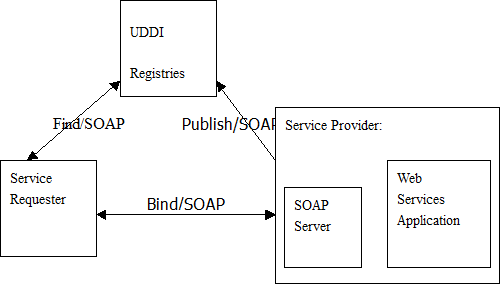Web services are self contained, self described and loosely coupled software components that can be described, published, discovered and called through the network. In the Web services system, all application entities are abstracted into services. There are three entities and three operations. Three entities: (1) Service Provider. From a business perspective, it refers to the owner of the service, and from an architecture perspective, it refers to the platform that provides the service. (2) Service requester. From a business perspective, it refers to enterprises that need to request specific functions, and from an architecture perspective, it refers to client applications that find and invoke services. (3) Service Broker. It refers to the repository used to store service description information. Service providers publish their services here; The service requester looks up the service here and gets the binding information of the service.
Three operations: (1) Publish. The service provider needs to first describe the service and publish it to the registration server. In the publishing operation, the service provider needs to pass the authentication of the registration server to publish and modify the service description information. (2) Find. The service requester sends a query request according to the standard interface provided by the registration server to obtain the relevant information required for binding the service. In the search operation, there are generally two search modes: one is the Browse Pattern, that is, the service requester can browse or search by some keywords according to the general classification standard, and gradually narrow the search scope until it finds the service that meets the needs. The search result is a collection of a series of services; The other is the Drill down Pattern, that is, the description information of a specific service is directly obtained through a unique keyword, and the search result is unique. (3) Binding. The service requester configures its own system by analyzing the service binding information obtained from the registration server, including the access path of the service, parameters of the service call, return results, transmission protocols, security requirements, etc., and then calls the service provided by the service provider remotely.
System construction principles
1. Scalability The system facilitates the generation of new business and the connection between other systems and the platform. In addition, the system provides a dynamic page customization tool, which can effectively help operators generate product and service pages, facilitate managers to expand information such as categories, and have high flexibility in rights management and member management.
2. Supportability
Ensure the reliability of membership through detailed registration information. In order to prevent online disputes, the user's interactive process information is saved in the form of log as the original basis for disputes.
4. Extensibility
Ensure the compatibility of existing platforms and systems and their adaptability to future development, so that the system can be upgraded and updated on the original basis, and fully consider the impact of technological progress factors.
5. Openness
The platform is not a closed system. It can be connected to other platforms or systems through interfaces in the future. In the construction of the platform, full consideration should be given to the needs of exchange with external information systems to ensure that it can not only meet the needs of basic functions, but also has the ability to exchange and process information with external systems.
6. Security
During system planning and design, system security should be fully considered to prevent illegal operations and malicious intrusion from causing system disasters and causing losses to institutions and individuals using the platform.
7. Reliability
The platform provides 365 × 24 × 7 non-stop services, fully considers system reliability in system planning and design, and adopts backup schemes or other management and technical means to improve system reliability, so as to avoid catastrophic consequences caused by system collapse.


